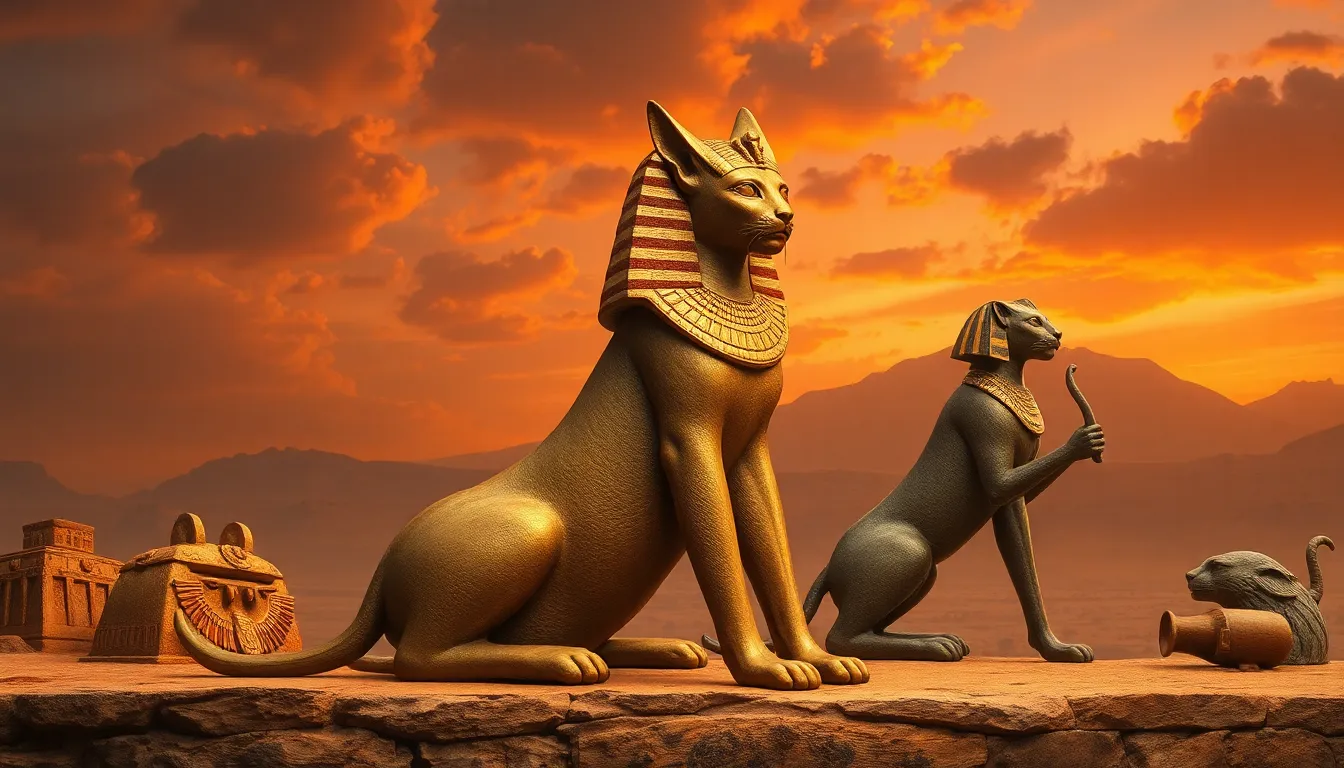The Cult of Bastet: From Fierce Lioness to Domestic Goddess
I. Introduction
Bastet, one of the most revered deities in ancient Egyptian mythology, embodies the duality of fierce protection and nurturing motherhood. Initially depicted as a lioness, her image transformed over time, reflecting the changing dynamics of Egyptian society. The significance of Bastet extends far beyond her mythological role; she represents the complexities of femininity, strength, and domesticity in ancient cultures.
This article aims to explore the origins, evolution, and cultural significance of Bastet in ancient Egypt, highlighting her journey from a warrior goddess to a beloved domestic figure.
II. The Origins of Bastet
Bastet’s origins can be traced back to the Second Dynasty of Egypt, where she was initially associated with the fierce lioness imagery. Her early depictions often depicted her as a lioness, symbolizing strength, protection, and ferocity.
Over the centuries, Bastet’s character evolved, reflecting the changing values and beliefs of Egyptian society. By the time of the New Kingdom, she had transitioned into a more domesticated form, often represented as a woman with the head of a domestic cat.
In the religious context of ancient Egypt, Bastet was venerated as a protective deity. She was believed to safeguard the home, children, and women, making her a significant figure in family life.
III. Bastet as a Fierce Lioness
In her warrior aspect, Bastet was revered for her protective qualities. She was often associated with the sun god Ra and was believed to defend the pharaoh in battle, embodying the strength and might of a lioness.
The role of Bastet in protection and warfare was critical, particularly during an era when warfare was prevalent. She symbolized the ferocity of a lioness, striking fear into the hearts of enemies and ensuring the safety of her worshippers.
The symbolism of the lioness in ancient Egypt extended beyond mere representation. Lions were viewed as embodiments of power, courage, and nobility. Bastet’s association with these attributes reinforced her status as a fierce protector of the people.
IV. Transition to the Domestic Goddess
As time progressed, the worship of Bastet shifted, reflecting a cultural transition towards more nurturing attributes. This evolution marked her transition from a warrior goddess to a domestic goddess.
Bastet became associated with fertility, motherhood, and the home. She was revered as a guardian of families and children, embodying the nurturing aspects of femininity. This shift allowed her to become accessible to the common people, emphasizing domestic harmony and family values.
Moreover, the significance of cats in ancient Egyptian households cannot be overstated. Cats were sacred animals to Bastet, symbolizing grace, protection, and fertility. Households often kept cats to honor her, as they were believed to ward off evil spirits and bring good fortune.
V. Bastet’s Worship and Cult Practices
The worship of Bastet was prominent throughout ancient Egypt, particularly in the city of Bubastis, where a grand temple was dedicated to her. This temple served as a center for her cult, attracting pilgrims and worshippers from all over the region.
Rituals dedicated to Bastet often included:
- Offerings of food and flowers
- Prayers for protection and fertility
- Celebrations during the festivals dedicated to her
Festivals celebrating Bastet were vibrant and joyous occasions, characterized by music, dancing, and feasting. The most famous of these was the Festival of Bubastis, which drew thousands of worshippers who traveled in boats along the Nile to honor the goddess.
The role of priests and priestesses was crucial in the worship of Bastet. They conducted rituals, maintained her temples, and ensured that the goddess was honored appropriately.
VI. Iconography and Symbolism
Bastet’s artistic representations varied significantly over time. Initially depicted as a fierce lioness, she later appeared as a woman with a cat’s head, symbolizing her dual nature.
Symbols associated with her worship include:
- The sistrum, a musical instrument that was often used in rituals
- The ankh, symbolizing life and fertility
- Lotus flowers, representing rebirth and beauty
The domestic cat, which Bastet was intimately connected with, became a sacred animal in ancient Egypt. Killing a cat, even by accident, was considered a grave offense, reflecting the high regard in which they were held.
VII. Legacy and Influence
Bastet’s legacy extends beyond ancient Egypt, influencing later cultures and religions. Her duality as a fierce protector and nurturing figure resonates in various mythologies and has inspired countless artistic and literary representations.
In modern times, Bastet is often interpreted as a symbol of femininity, strength, and independence. The cultural significance of cats has also endured, with many contemporary societies cherishing cats as beloved companions and symbols of protection.
VIII. Conclusion
In summary, Bastet embodies a unique duality as both a fierce lioness and a nurturing domestic goddess. Her evolution reflects the complexities of ancient Egyptian society, highlighting the importance of femininity in both strength and nurturing roles.
The enduring legacy of Bastet continues to inspire and inform our understanding of ancient mythologies, reminding us of the rich tapestry of beliefs that shaped human culture over millennia.
Understanding the significance of deities like Bastet allows us to appreciate the intricate connections between ancient beliefs and contemporary values, enriching our view of history and mythology.




